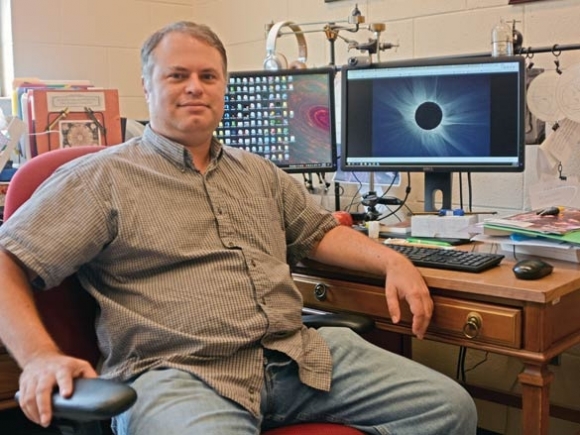Roller coaster in the sky: Solar eclipses inspire awe and enchantment for WCU professor

Enrique Gomez was 16 years old the first time he experienced the shadow of the moon.
Gomez, now an associate professor of physics and astronomy at Western Carolina University, is originally from Mexico. And while his family had already moved to the United States when the 1991 solar eclipse passed over Mexico City, they just so happened to be in town that summer for a visit with Gomez’s grandparents.
“I still remember vividly many aspects of that change of light and what the sun looks like when you see it unfiltered with the naked eye during totality,” Gomez said.
Even at 16, Gomez had a strong proclivity for science and astronomy. He’d already begun making his own celestial observations and submitting them to both professional and amateur astronomy societies, and by the time the solar eclipse came around, he’d been reading for months about what to expect, even purchasing a small telescope for the occasion.
He wasn’t disappointed. The experience was stirring, visceral, unforgettable.
As the moon began to eclipse the sun, the colors of the sky changed to the bright hues common at sunrise and sunset, but the experience was disorientingly distinct from anything that would occur in a typical day. The sun was still high in the air, making the shadows short and sharp. As totality came nearer, the shadow of the moon was visible racing ever nearer over the landscape.
Related Items
Then, for about six minutes, the sun was completely covered, its corona shimmering around the edge of the moon. Everything went dark, and silent. Stars became visible, and planets too. Gomez could see Venus and Saturn, as well as Sirius, the brightest star in the sky. His grandmother, who had seen eclipses before, had told him he’d be able to see flares around the sun when totality happened, but he didn’t quite believe her.
As it turned out, she was right.
“I’ve never seen anything as bright crimson red as those red flares all around the disc of the moon,” he said. “I was actually taken aback.”
The sky above him was clear, but in the distance he could see a big thunderstorm moving across the open landscape, lightning flashing in the clouds. It was almost like riding a roller coaster while standing still — except more dizzying.
“It’s a really weird feeling because with a roller coaster as you go over the edge you know you’re falling, and you’re falling towards the ground,” Gomez said. “Here when you’re in a flat area and you are looking at the sky with the stars up and the sun eclipsed by the moon and the corona from the sun, you get the feeling that you are about to fall into the sky.”
Even the animals seemed to be holding their breath. The neighbors had chickens, which Gomez saw “dutifully go into their coop before totality and after totality they came out.” When totality ended, the birds began to sing “very dramatically,” and the dogs began to bark. Seeing an eclipse on a farm among the barnyard animals would likely be a fascinating experience, Gomez said.
“The entire ecosystem around you has a response to it,” he said.
The experience stayed with him, and when he had a chance to experience an eclipse again eight years later, he jumped on it. It was 1999, he had just graduated from college, and his best friend from school was from Austria, where the eclipse was set to occur.
“He decided to call me up one day and say, ‘You want to come in and hang out for a couple weeks in Austria and see the eclipse?’ and I said, ‘Sure,’” Gomez recalled.
When eclipse day came, Gomez was afraid he wouldn’t be able to see it — it was August, in a place with a climate relatively similar to the climate here.
“It looked like it was almost going to be clouded over, but we managed to see the eclipse through the clouds,” Gomez said.
As it happens, the eclipse Gomez saw in Austria 18 years ago is the same eclipse that is set to take over Western North Carolina next week. Every 18 years, 11 days and eight hours, the sun, moon and earth enter the exact same configuration — and Gomez just so happened to find work at a university in the path of that same eclipse he once experienced on the other side of the globe.
“I’ve been talking about this eclipse to my students since 2008,” Gomez said.
For a couple of years now he’s been preparing for the scientific side of the big day. Gomez’ research recently has focused on radiation from supernova — some of that radiation makes its way through the earth’s atmosphere to its surface. Theoretically, he said, the moon shouldn’t do much in the way of blocking that radiation when it sits between sun and earth during an eclipse. However, there was a “very weird” observation during a 1995 solar eclipse in Calcutta, India, that showed a drop of cosmic radiation during the event.
“Now why is that?” Gomez asked. “The idea is that it’s not the moon necessarily blocking that radiation. It’s just the entire atmosphere is cooling.”
To test that theory, Gomez — along with many other teams spanning the entire country — will launch a balloon on Aug. 21 to collect data on temperature and radiation as it travels through the atmosphere. He’s been busy in the lead-up to the big day, launching other balloons gathering similar data on more cosmically typical days and refining the lightweight boom that will house all the scientific equipment attached to the balloon.
“The dataset on that day will actually be pretty rich,” he said.
WCU isn’t the only nearby college to see Aug. 21 as an opportunity for data collection. Southwestern Community College will launch a balloon as well — also part of a network, though a different one than what WCU is part of — to livestream and photograph the eclipse from an altitude of 90,000 feet. The balloon will launch from Anderson, South Carolina.
SCC will also be hosting scientists from Appalachian State University and the N.C. Science Museum, and will work with NASA on a massive event at Clingmans Dome in the Great Smoky Mountains National Park. The event will include a citizen science element, encouraging folks to pre-download and take data with the iNaturalist, Eclipse Soundscapes and GLOBE Observer apps listed at eclipse2017.nasa.gov/apps.
“We’re trying to get people to take charge of their own understanding of science and realize that without training or a degree, all it takes to be a scientist is to be curious and to look for those answers and then report on them, whether they’re what we expect or not,” said Matt Cass, principal investigator of the Smoky Mountains STEM Collaborative and physics instructor at SCC.
Gomez is more than hopeful that the eclipse will catalyze a wave of interest in science and astronomy — he’s seen two eclipses and knows better than most what a profound impact the experience can have. For Gomez, every sunset is a reminder of his place on this curved planet, every glimpse of the Milky Way a dramatic portrayal of the collected light of 200 billion stars and gas clouds.
“I go through life amazed by how amazing and dramatic the world is,” Gomez said.
Maybe, after Aug. 21, more people will find themselves experiencing that same level of awe.
“One of the reasons why I’m excited about this is that for just at least a couple of minutes, potentially up to 100 million of my fellow Americans are going to see the universe in the way I see it just about every clear evening,” Gomez said. “They’ll be seeing their relationship, experiencing their relationship with the sun and the moon and themselves where they are on the surface of the earth.”
After all these years of looking forward to the eclipse, preparing for the eclipse, telling his students about the eclipse, Aug. 21 will have a bittersweet ending for Gomez. But for the millions of people who will go to bed having stood in the shadow of the moon for the first time in their lives, it could be the beginning of something new — a boom of interest in science and astronomy.
“I’m hoping for a little bit of a sea change,” Gomez said.
Experience the eclipse
Southwestern Community College will deploy a balloon to video the eclipse live from Anderson, South Carolina at eclipse.stream.live. The team is called the SCC Mountain Flyers.
For those who would like to contribute to the scientific efforts themselves, NASA has listed a variety of apps to predownload before the event in order to help take data. Citizen scientists can enter data related to cloud cover, animal behavior and sounds during the eclipse using apps such as GLOBE Observer, iNaturalist and Eclipse Soundscapes. eclipse2017.nasa.gov/apps.









